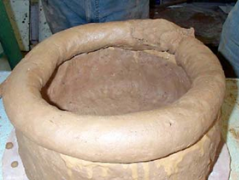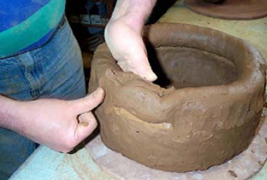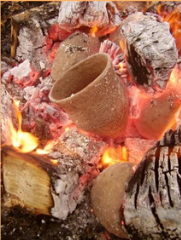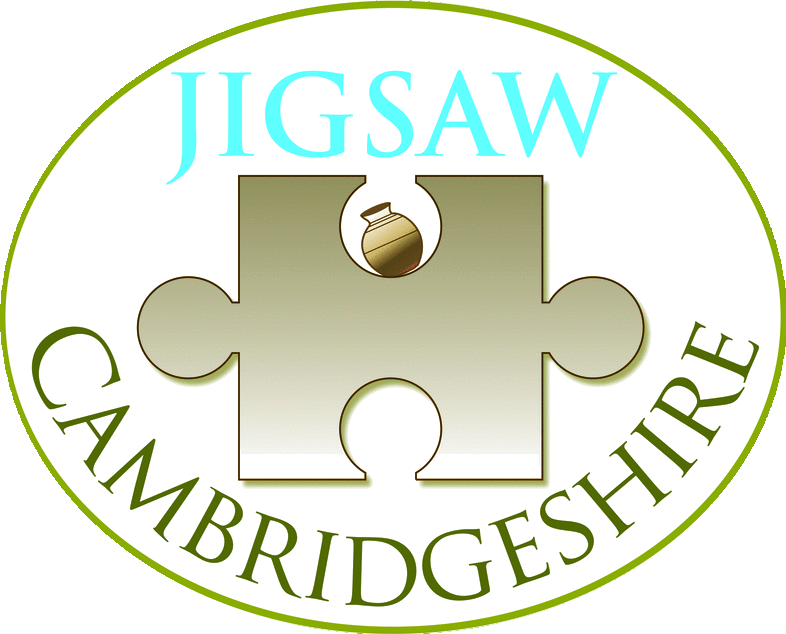Introduction
This short guide describes the types of pottery which were in use in Cambridgeshire from the Early Neolithic until the mid-Bronze Age. All pottery during this period was made and used in the household and was handmade, mostly formed using coil construction. The pots were fired in a domestic hearth, bonfire or clamp, at temperatures of 600 to 700 degrees centigrade. Based on evidence from ethnographic comparisons most archaeologists believe that clay collection, preparation and potting were undertaken by women. There were no pottery industries or production centres such as those found during the Roman or medieval periods however certain forms and fabrics were widely adopted during specific periods allowing pottery to be used for dating archaeological deposits. Prehistoric pottery may be found in both funerary and domestic deposits and archaeologists use pottery as evidence of trade and exchange and of the type and scale of activity present on an archaeological site.
Characteristics used to identify the age of a pot include form (the shape of the vessel), decoration, and fabric. Fabric here refers to the clay of which a pot was made and the inclusions within it. Inclusions are materials within the body of the clay which may be present naturally or are often deliberately added as temper, to aid construction, firing and resilience of the pot or for cultural or social reasons. The colour of the finished pot tells archaeologists something of how it was fired. Dark grey or ‘reduced’ pots are fired in an atmosphere where oxygen has been excluded whilst lighter, red or orange vessels are fired in an oxygen rich atmosphere. The consistent firing and regular colours found in much earlier prehistoric pottery indicate that ancient potters were skilled in controlling the firing conditions in which they produced their vessels.


Experimental archaeology is a good way of studying prehistoric pottery manufacture. The images above from ‘The Orkney Grooved Ware Experiment’ show pots being made using coil building.

The image above by experimental potter Graham Taylor shows bonfire firing of replica prehistoric pottery.
Further Reading
Elsdon, S., 1989, Later Prehistoric Pottery. Princes Risborough: Shire Publications.
Gibson, A., 1986, Neolithic and Early Bronze Age Pottery. Princes Risborough: Shire Publications.
Gibson, A., 2002, Prehistoric Pottery in Britain and Ireland. Stroud: Tempus
Gibson, A. and Woods, A., 1997, Prehistoric Pottery for the Archaeologist (2nd ed.). Leicester: Leicester University Press.
Lang, Lloyd, 2003. Pottery in Britain 4000BC to AD 1900. A Guide to Identifying Pot Sherds. Witham, Greenlight Publishing.
Prehistoric Ceramic Research Group Guidelines http://www.pcrg.org.uk/News_pages/PCRG%20Gudielines%203rd%20Edition%20(2010).pdf
There is also a more in-depth Jigsaw guide to Late Bronze Age and Iron Age Pottery found in Cambridgeshire available to download from our website: http://jigsawcambs.org/
Earlier Neolithic Pottery 4000-3500 BC
Pottery was not invented in Britain but was introduced from the continent in around 4000BC. The introduction of pottery is contemporary with the first farmers, who cultivated cereals and kept some domesticated animals. Earlier Neolithic pots are found in a limited range of forms. All are round-based bowls which could sit easily on the ashes of the hearth for use as cooking pots or in a depression in the floor for storing food. The bowls are often very well made and have smoothed or burnished surfaces. Burnishing, or polishing with a flat smooth stone, closes the surface of the pot making it more waterproof and gives an attractive shiny appearance.
The earliest of the Neolithic Bowl pottery is undecorated and often has a sharp change of angle or shoulder, between the neck and body of the vessel. The rim is often folded or rolled over. This form is often called Carinated Bowl from the shape of the vessel but can be called Grimston Lyles Hill in older literature named after the sites at which it was first identified archaeologically.
In Cambridgeshire Carinated Bowl can be made of flint-tempered fabric or shell-tempered fabric. The clay is well-fired to a dark grey brown colour and the surfaces are often well finished. The Early Neolithic period is characterised by the use of carinated bowls along with monuments such as causewayed enclosures, long barrows and chambered tombs as well as the predominance of multiple inhumations.
Locally Earlier Neolithic pottery is most often found in pits, tree-throws or ancient soil layers on domestic occupation sites.
More commonly found on Earlier Neolithic sites in East Anglian are undecorated bag-shaped or ‘S’ profile bowls with heavier rims than are found on the Carinated Bowls. These bowls are sometime called Plain Bowls or
Developed Bowl as they may represent a development from Carinated Bowl and are perhaps a little later appearing around 3700BC. These bowls are made of similar flint or shell-tempered fabrics to those used for Carinated Bowl and it is often difficult to identify sherds of these earliest Neolithic pots to a specific form. Identification is further hampered by the persistent use of flint and shell in later prehistoric pottery. It is therefore useful to look at other artefacts you may find with the pottery, especially flint tools, which will help identify its age.
Probably around the same time that Developed Bowl appears in the archaeological record the first decorated vessels are also beginning to be made. In Cambridgeshire the local decorated bowl form is known as Mildenhall Ware after the large settlement site at Hurst Fen Mildenhall where it was first identified. These bowls are also round based and made of flint-tempered fabric and most often have a thickened or ‘T’ shaped rim, a concave neck and sharp shoulder. The rim and upper body are elaborately decorated with patterns of stabbed dots and short incised lines. Mildenhall Ware was in use from around 3700BC to 3400BC.
Middle Neolithic Pottery 3500-3000/2800 BC
During the middle Neolithic pottery continues to be characterised by the use of flint-tempered fabrics and stabbed or impressed decoration, now using a range of tools particularly whipped or twisted cord wrapped around a stick and pressed into the wet clay, the end of bird bones, hollow reeds or quills and fingertip and fingernail impressions.
In East Anglia the local impressed ware is called Peterborough Ware. Peterborough Ware came into use alongside a number of changes in settlement patterns and monument forms around 2700BC; these include the adoption of cursus monuments and bank barrows, a greater number of ring ditch monuments and a movement towards single inhumation and cremation as the predominant burial rites.
Three types or sub-styles of Peterborough Ware are found in East Anglia. Ebbsfleet bowls are simple, undecorated or sparsely decorated and round-based bowls; Mortlake bowls are round based and highly decorated with elaborate rim forms and Fengate vessels have a distinct collar and narrow, flat base (Gibson 1995).
Later Neolithic/Early Bronze Age Pottery 3200-1800 BC
In the period which spans the end of the Neolithic to the beginning of the Bronze Age two types of pottery were commonly in use in East Anglia. The first is Grooved Ware, named for the distinctive decoration of incised channels or lines which often covers its exterior surfaces. In older literature this type of pottery is sometimes called Rinyo-Clacton Ware, a name which reflects it widespread distribution from Scotland to southern England. In East Anglia
Grooved Ware is most commonly found in pits, sometimes deliberately placed in carefully arranged deposits, for example stacked in piles or as a lining around the pit base.
Grooved Ware pots are often made with grog-tempered fabric, meaning that it contains crushed pieces of pottery which was added to the clay by the potter. The addition of grog helps when forming the pots and improves thermal resistance and resilience meaning that it does not shatter so easily when being used for cooking. In Cambridgeshire shell-tempered Grooved Ware is also found. The vessels have flat bases and are tub or barrel shaped.
Three sub-styles of Grooved Ware have been identified in southern Britain and are widely referred to the literature, however the chronological succession and tight geographical distributions initially identified for each sub-style have been shown to be less certain now that many more examples of each type have been found and radiocarbon dating has become more widespread.
Durrington Walls style Grooved Ware is named after a large Causewayed Enclosure site in Wiltshire. Pots of this sub-style are large, bucket and barrel forms decorated with horizontal or vertical cordons forming panels filled with elaborate designs of zig-zags or sometimes spirals. Clacton vessels are more plainly decorated with simple rims with grooves or applied wavy bands of clay running around the inside whilst the outside is decorated with incised lines and dots within incised chevrons or lozenges. Woodlands sub-style tub-shaped pots have bands of clay stuck on the exterior forming a lattice with knots at the intersections, perhaps imitating a net or basket.
Beaker pottery is also used in the later Neolithic early Bronze Age, being largely contemporary with Grooved Ware but perhaps coming in a little later. Beaker was a new style of pottery introduced from Europe and was used for cooking and storage and as part of funerary rites. Like Grooved Ware, Beaker pottery is often grog-tempered but can be made of sandy fabrics or, occasionally shell-tempered fabric.
Beakers are highly decorated vessels often with curvy S profile bodies. Decoration can be incised, tool impressed or fingertip-impressed. Coarse fingertip-impressed decoration (also known as rustication) comprises pinched or jabbed fingernail or fingertip patterns covering the body of the vessel. These more robust Beakers with rusticated decoration are most often found on domestic sites. Beakers decorated with tool impressions, carried out with a bone or wooden comb, seashell, stick or twisted cord, tend to be finer and are found both in occupation and in funerary contexts often accompanying inhumation burials such as the Amesbury Archer. Beaker was in use from around 2500-1800BC.
Food Vessels were so named by the antiquarians who first studied them because they believed these robust vessels were used for food preparation in contrast to the more finely made drinking vessels or Beakers. In fact both types of pottery were used for a range of household and funerary purposes, though domestic deposits of Food Vessel are rare. In East Anglia Food Vessels are less common than in northern Britain being found occasionally as grave goods accompanying inhumations in barrows or as containers for cremations. Food Vessels are made of chunky fabric often with large grog inclusions.
Two shapes of Food Vessel are recognised, a dumpy ovoid ‘bowl’ and a taller ‘vase’ form. Both have rims with wide rim tops sometimes sloping to form an internal bevel which is decorated, frequently with cord impressions. Whist bowls have simple, rounded bodies, vase forms curve inwards below the rim to a deep concave neck or ‘cavetto zone’ widening at the girth then tapering again to the base. The exterior of Food Vessels is decorated, most often with short cord impressions or ‘maggots’ formed from a piece of cord wrapped around a stick and pressed into the surface of the clay. Recent research has suggested that Food Vessels were in use from around 2200/2100 until c.1800 (Neil Wilkin pers. comm.).
Collared Urns are broadly contemporary with Food Vessels with dates for use spanning c.2200/2100 to c.1450 and had a similar function, being rarely found in settlement contexts and more commonly in burials and as cremation urns in barrows. Collared Urns are mostly grog-tempered and are named for the prominent rim which forms a wide band or collar around the top of the vessel. Because of this Collared Urns were formally known as Overhanging Rim Urns. Collared Urns are often large and thick-walled with decoration around the rim top and collar whilst the lower body is plain. The decoration is frequently formed of cord impressions either similar to those seen on Food Vessels or forming geometric designs such as filled panels or hurdles.
Mid Bronze Age Pottery 1800-1100 BC
Urns continue to be used into the middle Bronze Age when they form what is known as the Deverel-Rimbury pottery tradition. Several regional styles of Deverel-Rimbury urn are recognised across Britain however generic
Biconical Urns are widespread and form the most commonly documented generic group of Middle Bronze Age pottery. Biconical Urns are large vessels often found containing cremations, though also found locally on settlement sites especially on the Fen Edge. These grog-tempered urns flare out from the rim being widest at the shoulder and taper to a narrow base. The upper part of the vessels may be decorated, most commonly locally with applied clay strips forming a curved band resembling a handle and known therefore as ‘Biconical Urns with horseshoe handles’. Examples of these urns were often inverted over cremated remains in pits, the area around sometimes packed with stones.
In East Anglia the most widely studied group of Deverel-Rimbury pottery are the Ardleigh Urns, a type of highly decorated cremation urn found in cemeteries in northern Essex and southern Suffolk. The earliest Ardleigh Urns have elements borrowed from the Biconical Urns with horseshoe handles but as the tradition developed grog temper was gradually replaced by burnt crushed flint, the vessels became more barrel shaped and distinctive decoration of fingertip impressions and applied bands or cordons appeared. The stabbed fingertip impressions could be applied all over the body of the vessel or be restricted to the rim top and or applied cordon.
Domestic variants of the Deverel-Rimbury pottery tradition are beginning to be recognised, often in field boundary ditches, though other settlement evidence is limited. These tub or barrel shaped jars and cups are flint-tempered, often with fingertip decoration along the rim tops and on decorated cordons and are the forerunners of the Post-Deverel-Rimbury of the Later Bronze Age to earlier Iron Age.




